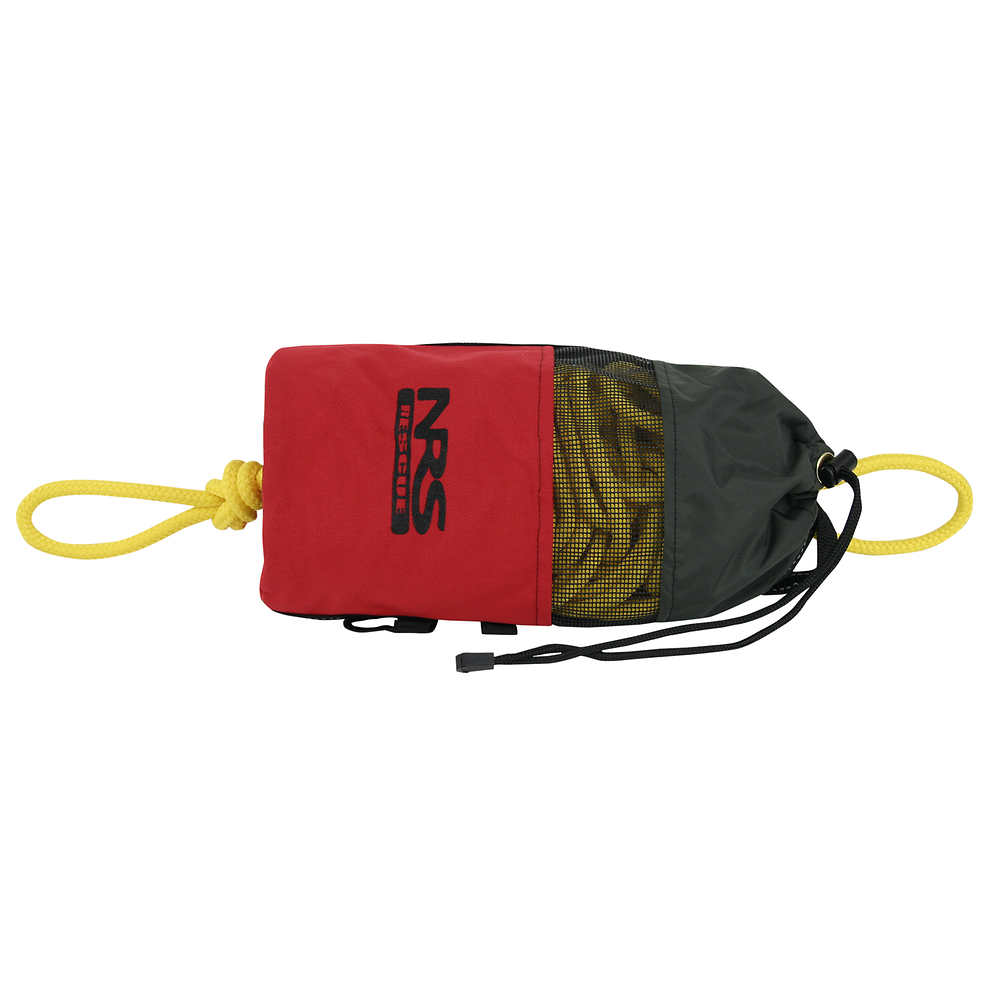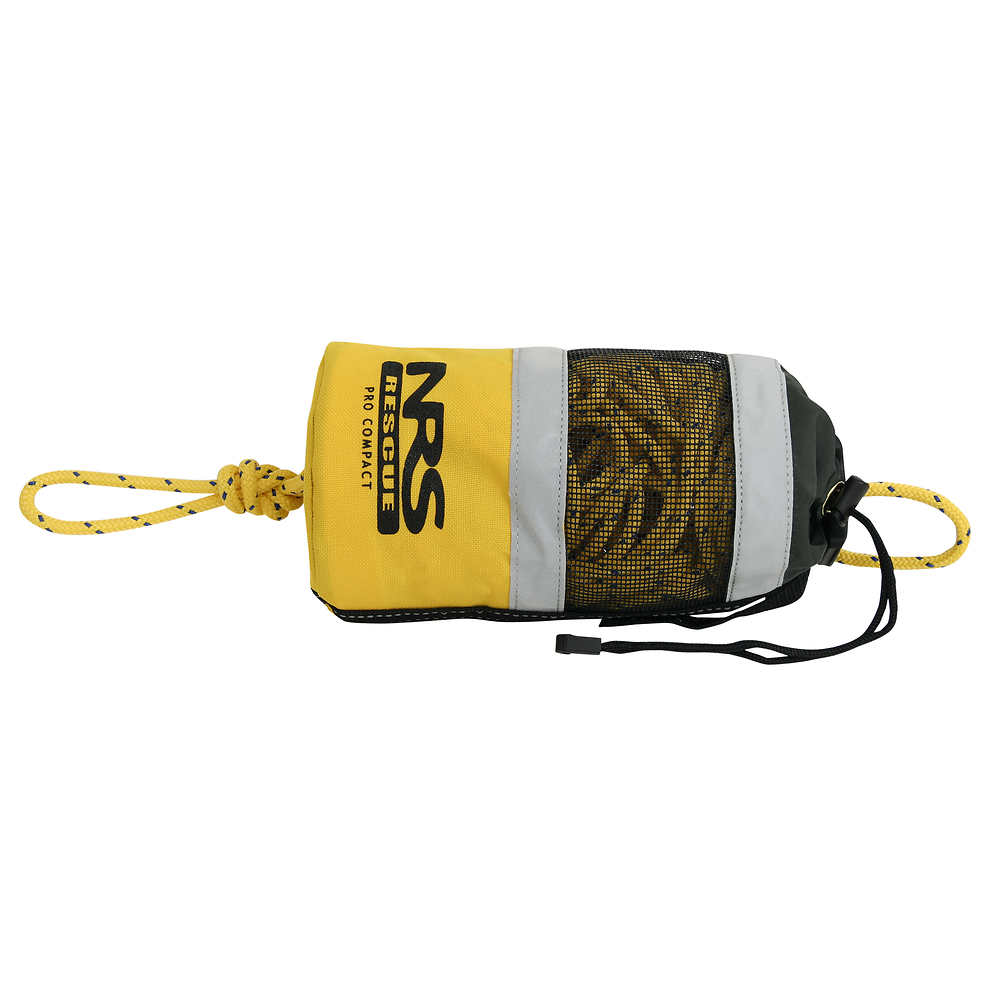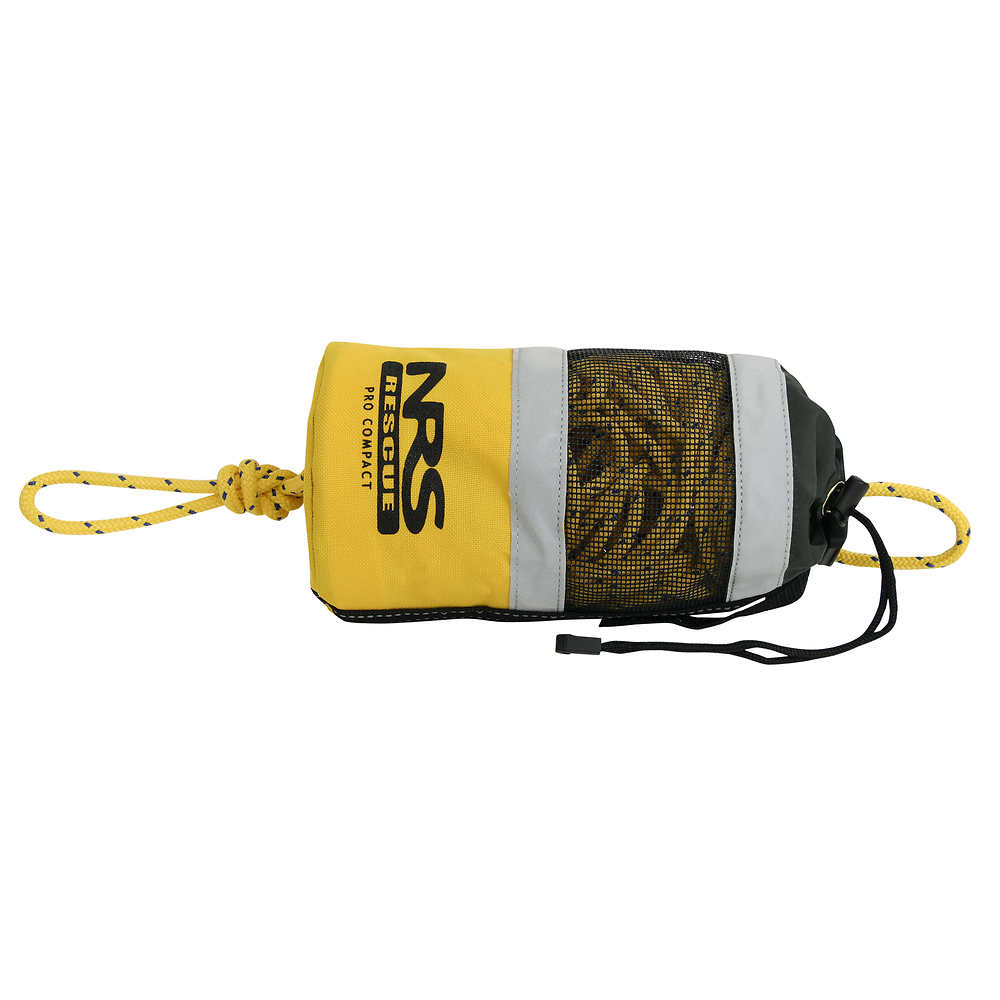River Rescue Throw Bag Investigation
There is perhaps no more basic a rescue tool in whitewater river rafting and kayaking than rescue rope, typically stuffed into a bag, and then stuffed into the corner or a raft or inside someone’s kayak. On the river, rope can accomplish more than any other rescue tool, and can extend the rescue radius of any river rescue by double or triple, at least. Almost as important as having a rescue throw bag is having one with enough tensile strength that it can handle all of the tasks required of it during any foreseeable rescue, while not being too difficult (i.e. too heavy) to throw. We’ll start with the basic 75 foot rescue throw bag, which is manufactured by every whitewater rafting equipment supplier, most commonly used in the USA on commercial rafting trips are the bags by Northwest River Supply.
A standard NRS Rescue Throw Bag with 75 feet of rope and a tensile strength of 1900 pounds.
The NRS Standard Rescue Throw bag has 75 feet of 3/8” polypropylene rope rope with a 1900 pound tensile strength, stuffed into a bag with a piece of foam in the bottom of it to ensure it doesn’t sink. This is the industry standard, and by all means the yardstick that we’ll analyze all of the throw bags here.
This bag is fairly easy to throw both overhand and underhand, and many professional guides and seasoned boaters have perfected the art of throwing the bag to the point where they can throw it to the very end of the rope; meaning that every time they can throw 75 feet. This is pretty impressive to watch from dry land, and if someone can toss a throw bag from a moving raft that is tumbling down a whitewater river, and do so with accuracy, in an actual rescue scenario, and actually hit (or come close to hitting) the whitewater swimmer with the rope, they deserve to get some kind of prize or have a blog written about them. (or at the very least get a raise from their outfitter).
The problem with this rescue rope is that it’s 1900 pound tensile strength limits what it can do in more serious swiftwater rescues. A raft full of people/guests/paddlers (lets go with 8 people plus guide), a first aid kit, pin kit, and some other necessities, is itself going to weigh upwards of 2000 lbs. So the rope itself isn’t as strong as the raft and cargo is heavy; this is going to create problems and a potentially dangerous situation if you pin the raft with everyone in it. At our swiftwater rescue trainings done by the Swiftwater Safety Institute, the instructors are constantly preaching not to overwork your gear, and if you do not have the proper equipment to put the rescue system together, don’t even try it, and rather wait until the right equipment can get to you, or otherwise recognize that you’ve got an imminent failed rescue on your hands. The bottom line is that 1900 pound strength rope, which is standard in these rescue throw bags, is great for pulling people to the raft, but if you want to do a z-drag, or serious “boy scout pull” to get a pinned raft off of a rock, you simply cannot do it without maxing out the strength of the rope. Which brings us to the savior; Dyneema, or what is often called “Spectra” rope.
At over twice the price, and twice the load carrying capacity of the standard rescue throw bag, bags with “Spectra core” rope technology are the industry standard when it comes to rescues that involve mechanical advantage and/or real life saving reliability in difficult situations. The NRS Pro Rescue Throw bag is filled with the standard 75 feet of 3/8 inch Spectra core Dyneema rope, and comes with a tensile strength of over 5000 pounds. This conjures up memories of the old tv show “Home Improvement” and the iconic grunting of Tim “the toolman” Taylor who always seemed to find a tool with too much power for the job. Well, the reality is that if you have a rescue that requires a rescue rope with more than 5000 pounds of strength; needless to say, you’ve really screwed up, and no matter how things end up your name and likely pictures of your raft (or what used to be your raft) will begin circling Facebook and you’ll probably have someone write a blog about your misadventure. The point is that 5000 lbs. of strength is enough to handle almost any typical whitewater river rafting misadventure that often befalls the commercial raft trip outfitter. Furthermore, if you’re going to be tied in to your rescue PFD in a real life “live bait” or “strong swimmer” whitewater rescue, there is a certain peace of mind being tied in with a rope strong enough to lift your Toyota Corolla off the ground.
The advantageous NRS "Pro" Rescue Throw Bag, with 75 feet of Spectra core rope and a tensile strength of over 5000 pounds.
The problem with using Dyneema rope for your every day rescue throw bag is that they’re a little heavy and the rope is a little stiff; this makes rescues slightly cumbersome and for less muscle bound rafting guides that perhaps didn’t play shortstop in college, the distance of their rescue throw in a real life situation (think middle of the river in a raft that is rocking back and forth, with 2 or 3 people screaming, with cold fingers and a swimmer who is looking at the wrong side of the river for their rescue) to approximately 30 feet. In actual practice it may be beneficial to carry a smaller rescue throw bag with lighter rope, and next to it, or perhaps even better yet, inside a handy dry bag, would be your heavy duty rescue bag.
Of note are the “compact” NRS rescue throw bags. The standard bag has 70 feet of ¼ inch polypropylene rope with approximately 900 pounds of tensile strength, and the “Pro” type, with 70 feet of rope and a 2500 pound limit. Note: You may be thinking what we’re thinking, and you’re right, we were thinking it… that 2500 pound tensile strength packed into a tight little throw bag can be a pretty useful river rescue tool for smaller rafts, for kayakers, and for most rescue scenarios, and the bag is easy to throw in chaos. You’d be right, and 2500 lbs. of strength is a pretty handy rope to have at the ready, the only issue there (aside from the inability to do heavy duty rescues) is that the rope is thin and thus hard to hold on to, and the other fairly damming issue with the smaller rope diameter is that it doesn’t work well with a prussic. In order to get a prussic chord small enough to bite down on rope that small you’d be looking at 4mm, and then you’ve got a serious weakness in your system due to the smaller prussic. Nonetheless, these smaller bags are uber-useful due to their lightness and throwability from inside a raft, or otherwise in a situation where you don’t have the ability to get a really solid, Tom Brady-esque throw bag release (Joe Montana, Dan Marino, etc.). It’s a pretty solid plan to have a smaller bag in your raft within easy reach of the guide or the other paddlers, and then have a second, more serious rescue throw bag filled with spectra core rope for bigger rescues.
A Compact Pro Rescue Throw bag, with 70 feet of 1/4 inch Spectra core rope, and a tensile strength of 2500 pounds. A rope with more strength than a standard throw bag, but in a more compact bag.
Static ropes are a different animal altogether. This is a hotly debated topic, but one we’ll study in brief here. The idea here is that if you’re rafting on a whitewater river with any width to it (i.e. not a creek), then you’re really not going to be able to span the width of the river with only one 75 foot throw bag. When you think about the distance of 75 feet while sitting at your kitchen table, it seems like a long ways, but once you try and span the width of a rushing river, and then add to that a tie off, a z-drag, or whatever else is required of your rescue, the reality is that you’re going to run out of rope, and when you do you’re stuck between a rock (perhaps literally) and a proverbial hard place. That’s why it’s handy to carry multiple throw bags or a static line.
Unlike tying two rescue throw bags together to create your haul line, using a static rope (usually 150-300 feet of 3/8” rope specifically designed for rescues) eliminates having to “jump” the knots in your system, and gives you a really awesome foundation to perform some really great river rescue systems. With a well trained, confident rafting or kayaking crew, and a basic pin kit, coupled with a static rescue rope, you’re probably in good shape in just about any rescue. In this way, any river rescue that is serious, performed without the advantage of a static line, is going to be cumbersome. Using throw bags tied together to get the appropriate distance is just going to gum up the system. So, it may be advisable to carry a static line in your pin kit, or what most outfitters we’ve been around call, a “sweep kit”.
So in the sweep kits at Triad River Tours, which are increasingly elaborate as well as continuously debated amongst our professionally trained guide staff consisting of swiftwater rescue professionals, we have several large carabiners, prussic, tubular webbing, a bunch of other rescue goodies like a rigging plate, a waterproof notebook, et. al, and at the base of the drybag housing the kit is a full 300 feet of rescue rope. This gives us the ability to perform any rescue we may encounter under most circumstances. Later in the season, or on trips where our scenarios would be predictably more simple, we may keep this rope in our bus, or back at camp, and move to a system involving several throw bags. Because we always keep one small and one large spectra core throw bag on our trips, and because we will always have at least two crafts on any rafting trip, we will be able to rig together two throw bags for a total of a 150 foot improvised static line. Having only one throw bag on each raft presents several difficulties, and common sense will tell you that if you are to only carry one throw bag per raft, then you’ll really want to consider carrying a static line in one of the rafts (more often the raft in the rear of the pack). Keeping in mind that if you do not have access to this raft in a rescue, you will not be able to use the static rescue rope contained within it (so don’t put your least experienced guide in the sweep boat). Additionally, consider that if you are running a whitewater rafting trip with 3 rafts (a very common number from what we’ve seen on the rivers we’ve run), and each raft has 2 throw bags, and each guide has a small personal sweep kit (carabiners, prussic, webbing) then you probably have enough gear between the three of you to perform the necessary rescues you may encounter. Also keep in mind that weight is your enemy when it comes to rafting rescues; the more equipment you carry adds to peace of mind but comes at the cost of both convenience and maneuverability; and when some old school rafter tells you that it doesn’t matter how heavy the raft is, just spend a few minutes perusing Youtube under the search term “raft pin” and find a large raft full of gear, stuck on a rock in the middle of the river, and see how long it takes to get the thing unstuck. The point here is to use common sense and try and consider a multitude of factors. In a real river rescue, things happen fast, so preparation and being familiar with your system, and being ready to adapt and improvise your river rescue gear will be paramount to your success.
In the video below, one of the Triad guides does a simple simulation of a whitewater river rafting rescue involving a rescue throw bag retrieval.
Until next time friends, keep the bow pointed downstream, and enjoy your time on the river!
Read more:






















